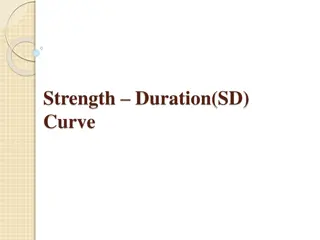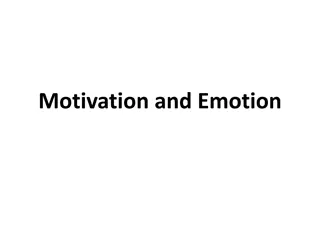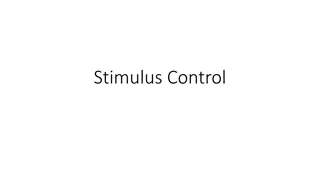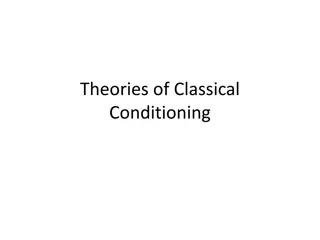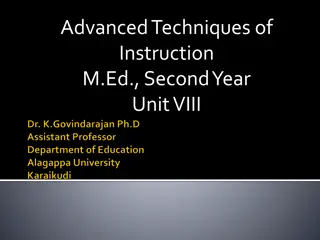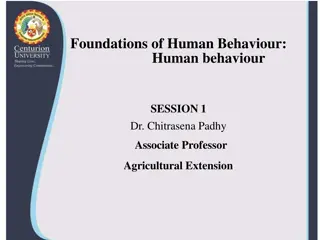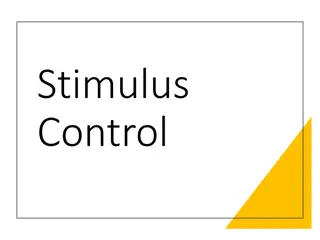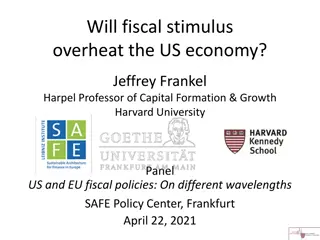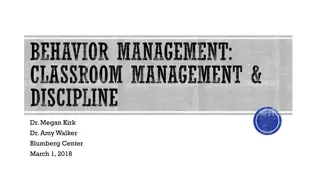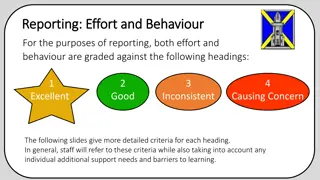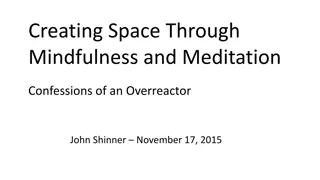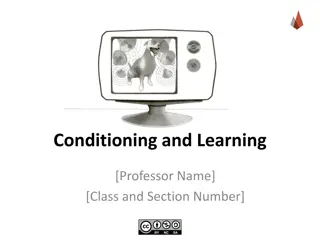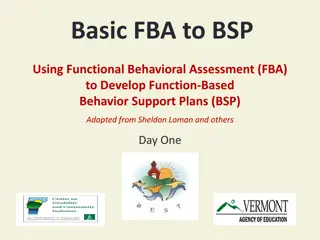Understanding Stimulus Control in Behavior
Behavior under stimulus control means its occurrence is influenced by the presence of certain stimuli. This principle explains how the likelihood of a behavior happening depends on specific cues in the environment. When a behavior is under stimulus control, it is more likely to occur in the presence of particular stimuli.
Download Presentation

Please find below an Image/Link to download the presentation.
The content on the website is provided AS IS for your information and personal use only. It may not be sold, licensed, or shared on other websites without obtaining consent from the author. Download presentation by click this link. If you encounter any issues during the download, it is possible that the publisher has removed the file from their server.
E N D
Presentation Transcript
Stimulus Control of Behavior Having stimulus control means that the probability of the behavior varies depending upon the stimuli present. If a behavior is under stimulus control then The behavior happens when the stimulus is present The behavior doesn t happen when the stimulus is absent Most of our behavior is under stimulus control A person that contributes to charity generously while in church may watch every penny spent while at work
Discrimination 1.2 CS+ CS- 1 Response Strength 0.8 0.6 0.4 0.2 0 1 2 3 4 5 6 7 8 9 10 11 12 13 14 15 16 17 18 19 20 21 22 23 24 25 26 27 28 29 Trials
Stimulus Control: Discrimination Stimulus Control: Discrimination Definition: Degree to which antecedent stimuli set the occasion for particular responses Precise degree of stimulus controlling responding E.g., Man has beard and is Daddy; Man has beard and is Uncle Eddie: Child only responds to bearded Daddy as Daddy Stimulus discrimination is taught by using discrimination training procedures such as differential reinforcement
Stimulus Control: Generalization Stimulus Control: Generalization Definition: When a response is reinforced in the presence of one stimulus there is a general tendency to respond in the presence of new stimuli that have similar physical properties ore have been associated with the stimulus. Loose degree of stimulus controlling a response E.g., All men with beards are Daddy Stimulus generalization is taught by using generalization training procedures: Reinforce any stimulus within the class of related stimuli.
Development of Stimulus Control Development of Stimulus Control Stimulus discrimination training requires One behavior Two antecedent stimulus conditions: the SDand the S Or the S+ and the S- Responses that occur in the presence of the SDare reinforced (thus, the response increases in the presence of the SD) Responses that occur in the presence of the S are not reinforced: The response decreases in the presence of the S ) Example: Reinforcing a child s saying red when someone asks What s your favorite color? and witholding reinforcement if they said red when asked What s your name?
SD: What s your favorite color? Response: red Reinforcer: Super! You said red! S : No praise What s your name?
Differential Responding Differential Responding When a child s behavior comes under the control of the SD, the SD has acquired stimulus control over the child s behavior So the verbal stimulus What s your favorite color? gains stimulus control over the response red why? And the child is discriminating or responding differentially
Stimulus Generalization Stimulus Generalization When a response is reinforced in the presence of one stimulus as well as similar stimuli The same behavior response tends to be evoked by stimuli that share similar physical properties with that controlling antecedent stimulus Stimulus Generalization is more likely when stimuli that are highly similar to the original stimulus are presented You stop at first traffic light you come upon in driver s ed, but you generalize your responding so you stop at any red traffic light in any city or town.
Stimulus Generalization Stimulus Generalization If you teach green using this color circle Student s most likely to say green Student s less likely to say green (discrimination) Student s less likely to say green (discrimination)
Stimulus Generalization Stimulus Generalization Respond to similar stimuli to the original stimulus E.g., similar people, materials, or settings Generalization is more likely when the novel stimulus is similar to the training stimulus
Stimulus Discrimination and Stimulus Stimulus Discrimination and Stimulus Generalization are a Continuum Generalization are a Continuum Stimulus Discrimination Stimulus Generalization Generally, as the training and test stimuli become more different responding will decline Produces a generalization gradient The gradient shows the degree to which discrimination or generalization has occurred.
Generalization Gradient Guttman & Kalish (1956) pigeons reinforced for pecking a 580 nm lit key (orange-yellow) (S+) on a VI schedule 350 300 250 Responses A test session was then given where many different colored key lights were presented in extinction 200 150 100 50 S+ 0 510 530 550 Wavelength (nanometers) 570 590 610 630
Interpreting Generalization Gradients Pigeons trained to peck a moderately bright light (S+) to get food. (S- = dim light) After asymptote is reached, present occasional non- reinforced probe trials at various wavelengths or levels of brightness.
Excitatory and inhibitory gradients Excitatory gradients form around the CS+; show where responding is MOST likely Inhibitory gradients also form; show where responding is least likely e.g., Pigeons trained to peck at a 800 hz tone (S+), with a 500 nm light S-.
Peak Shift Peak Shift Phenomena where the peak of the generalization curve shifts AWAY from the S- Means that the most responding does not occur for the S+, but slightly offset from the S+ and away from the S- The peak of responding shifts AWAY from the S- Question is WHY!
Lets do an example of Discrimination Training Two choices: 1 4 4 is the correct answer
Now what is the correct answer? Now what is the correct answer? Using the last question and correct answer, which is the best answer for each of the following? 3.9 -1 -1 5 0.9 3
Second problem: Think about it: Second problem: Think about it: 4 16 Again, 4 is the answer Now which is the best answer?
Now which is the best answer? Now which is the best answer? Using your answer from the last slide: Which is the answer for each of the following? 16 48 8 32 100 400
Examine your answers: Examine your answers: First set of slides: Tend to pick answer that is closest to 4 Second set of slides: Tend to pick the smaller (1/4 of the second answer) Why? Two theories may explain Spence s Summation Theory Kohler s Interdimensional Theory
Spences Theory Spence s Theory Peak shift occurs because of the summation of the excitatory and inhibitory curves Result is that the most responding is slightly in favor of the S+ Not as strong of suppression for S-; thus, get a slight shift away from S- when sum the two curves Just a math phenomenon
Spences Theory to Account for Peak Shift S+ 80 Inhibitory Excitatory Difference Inhibitory or Excitatory Strength 60 40 20 0 -20 S- -40 -60 490 510 530 550 570 590 610 630 650 670 Wavelength (nanometers)
Kohlers Kohler s Tranposition Tranposition Interdimensional theory Interdimensional theory The animal learns a conceptual rule: When given stimuli, choose whichever fits the characteristics of S+ to S- E.g.: S+ is always larger E.g.: S+ is the most green Thus, when given generalization stimuli, look for whatever is the most S+ compared to what should be S- .
Kohlers Kohler s Tranposition Tranposition Interdimensional theory Interdimensional theory Shift away from S+ occurs because the organism compensates for not S- , and overcompensate PAST the S+ but away from the S- Learning a concept: Always choose larger or greener, etc. Given a large and small stimulus, choose large even if it is too large If S+ is read and S- is green, choose the reddest but the least green .
Interdimensional discrimination 700 Pseudodiscrim Discrimination 600 500 # Responses 400 300 200 100 0 501 530 555 576 606 Wavelength Discrimination: S+ = 555nm Light; S- = Tone
Test of Theories Test of Theories Choose between squares: S+ 100 cm2 125 cm2 500 cm2 250 cm2 1000 cm2 500 cm2 ?????? S- 50 cm2 62.5 cm2 Situation: Original training Test 1: Spence s test Test 2:Kohler s test Spence's prediction: Will choose closest to original S+ Transposition or interdimensional: choose larger
Which is correct? Which is correct? Tests for summation yield evidence supporting Spence s theory When using stimuli close to the original stimulus Animal tends to make errors towards the original stimulus Tests for transposition/interdiminensional yield evidence supporting Kohler s theory When using stimuli highly different from original stimulus, error towards original stimulus But show concept rule in that keep the relation of the difference constant (e.g., choose the smaller one)
So, which theory is right? So, which theory is right ? BOTH! When the test includes stimuli close to the original S+, animal tends to choose the one closest to the S+ As differences become increasingly larger, animal tends to choose the stimulus consistent with the type of difference between the S+ and S- E.g., larger or red-er Why?
Teaching Stimulus Discrimination Teaching Stimulus Discrimination Discrimination is a fundamental process that controls behavior. Discrimination allows us to differentiate when reinforcement is available for specific responses. Many essential tasks require discrimination skills Reading. Labeling Objects. Following directions. Following activity schedules. Greeting people. Self-care skills.
Basic Problem of Discrimination Training Basic Problem of Discrimination Training Discrimination training teaches learners to Perform a specific response in the presence of a specific stimulus and Not to perform that response in the presence of other stimuli. Most stimuli are compound (they consist of different elements) It may be difficult to control which element(s) of the stimulus exert control over behavior We must be careful how we teach and what stimuli we use!
Stimulus Compounding Stimulus Compounding All stimuli are compound. They consist of many different elements. Modality (visual, auditory, tactile) Size, color, shape, etc. It is difficult to control which element or elements of the stimulus exert control over behavior. Need to be careful how we teach and what stimuli we use. Have organism attend to critical aspects of the S+
2 Types of Discriminations. 2 Types of Discriminations. Simple Discriminations. Non-Conditional Discrimination. Simple association A = B Conditional Discriminations. Matching-to-sample. Arbitrary Discrimination. Involves complex associations
Simple Discrimination Simple Discrimination Stimulus is present or not present Simple association: If red then apple One picture on the table that s a cat Say touch cat and they do Cue dog to sit ; sitting is the only correct response Not real life for most human tasks (or for dogs for that matter).
Conditional Discrimination Conditional Discrimination A response to a given stimulus is followed by a reinforcer if and only if another stimulus is present Said another way a stimulus is discriminative for reinforcement or no reinforcement depending on (conditional on) the presence of another particular antecedent Often taught via Match-to-Sample procedures If a picture of a dog, then say dog; if a picture of a cat, then say cat Vary the answer for the same reinforcement depending on conditional cue (dog or cat picture) Many programs consist of Identity Matching (matching identical stimuli): Objects Pictures Letters Shapes Colors Numbers
Match-to-Sample Learner 1st responds to sample (conditional stimulus) Sample Then responds to one of the comparison stimuli S /S- SD/S+ S /S-
Match-to-Sample SD/S+ SD/S+ Sample (Conditional Stimulus) Sample (Conditional Stimulus)
Establishing New Forms of Establishing New Forms of Conditional Stimulus Control Conditional Stimulus Control Identity matching (single mode) Visual: visual Auditory: auditory Arbitrary matching (multimodal) Visual: auditory Auditory: visual Auditory: tactile
Arbitrary Matching Arbitrary Matching Stimuli are not physically identical Different modalities (visual/verbal) Different types of stimuli: story problem; number answer Examples Match non-identical visual stimuli Object to pic, printed word to picture, object to printed word Match auditory stimulus to visual stimulus ( Receptive Identification ) Others?
Receptive Picture ID SD/S+ SD/S+ baby flower Sample Sample
Concept Formation Concept Formation Complex stimulus control that results in: Generalization within a class of stimuli and Discrimination between classes of stimuli Two procedures for teaching concept formation: Simultaneous Discrimination: The concurrent presentation of multiple stimuli Successive Discrimination: The successive presentation of multiple stimuli Teaching elements of a stimulus class!
Stimulus Class Stimulus Class Stimulus Class: set of stimuli that have a common effect on behavior (evoke the same response class) These would probably be in the same stimulus class for most people
Stimulus Equivalence Stimulus Equivalence Emergence of accurate responding to untrained and nonreinforced stimulus-stimulus relations following the reinforcement of responses to some stimulus-stimulus relations 3 aspects Reflexivity Symmetry Transitivity A B C DOG dog
Reflexivity Reflexivity In the absence of training, person selects an identical stimulus (AKA Generalized identity matching) Logic is A = A For example: Without specific training, the person matches
Symmetry Symmetry After being taught to match A to B, person can match B to A (without training) Logic is If A = B, then B = A For example After being taught to match to DOG Person can match to DOG
Transitivity Transitivity Critical test for stimulus equivalence if you get transitivity, the stimuli are members of an equivalence class After being taught to match A to B and B to C, person can match A to C (without training) Logic is If A = B and B = C, then A = C For example After being taught to match to DOG AND being taught to match to dog DOG The subject can match to
Factors Affecting the Development of Stimulus Control Reinforcement Differential reinforcement with rich schedules of reinforcement Preattending Skills Looking at type of instructor or materials, sitting up tall, no stereotypy or other misbehavior
Factors Affecting the Development of Stimulus Control Specificity of directions for responding to stimuli Should relate to discrimination Touch the correct response; say the correct word If ask for response unrelated to setting, get more errors Opportunity to respond Frequent, active opportunities to respond leads to higher rates of correct responses More opportunities for making conditional responses Pacing of response opportunities Higher pace often leads to superior performance and less off-task behavior Not lose attention during/between trials
Factors Affecting the Development of Stimulus Control Salience of the stimuli Influences attention and ultimately the development of stimulus control Dependent on the capabilities of an individual, the past history of reinforcement, and the situation Be aware of modality of presentation: E,g, Visual vs. auditory animals The more modalities the stimuli are presented, the better the concept formation.



